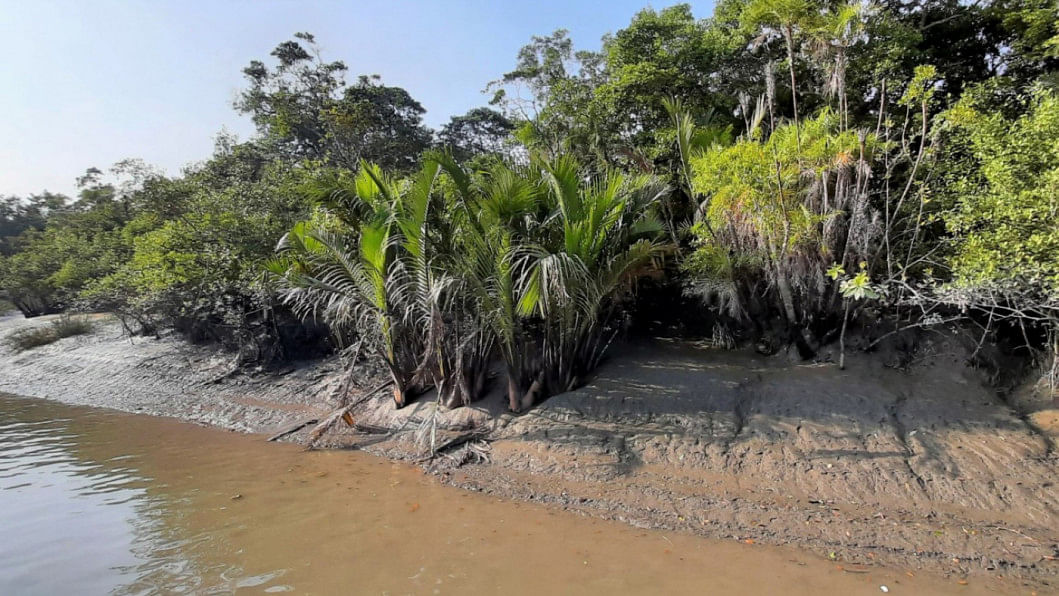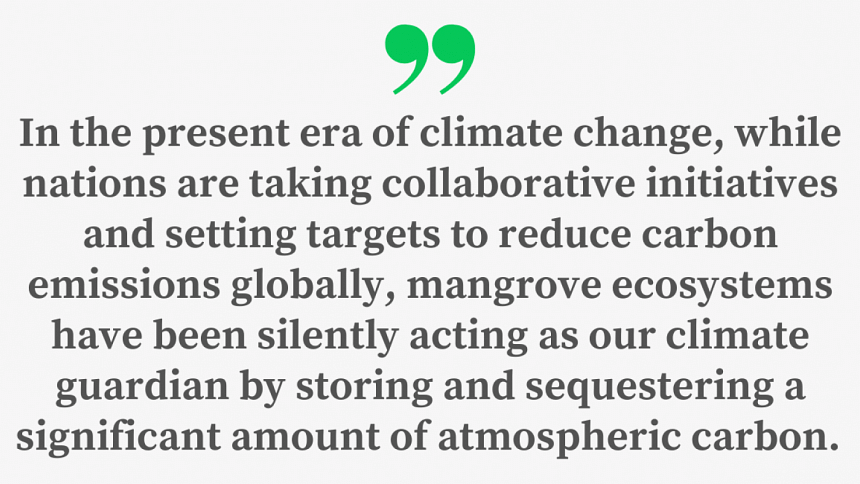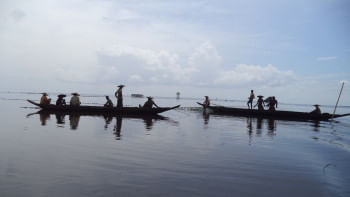Mangrove forests: Nature's frontier between life and loss

Over the past few decades, apocalyptic cyclones such as Sidr, Aila and Bulbul have wreaked havoc in the southwest coastal region of Bangladesh. Even though these tropical cyclones caused significant damage to both human lives and properties, extensive devastation was prevented because the Sundarbans, the largest mangrove forest in the world, served as a defensive wall against the deadliest winds. Functioning as a natural barrier, intricate branches and leaves of the mangrove trees play a pivotal role in lowering the height of storm surges. Therefore, the existence of mangrove forests in the coastal region of any deltaic country, like Bangladesh, is an enormous blessing.
In the present era of climate change, while nations are taking collaborative initiatives and setting targets to reduce carbon emissions globally, mangrove ecosystems have been silently acting as our climate guardian by storing and sequestering a significant amount of atmospheric carbon. A report published by The World Bank shows mangroves in Indonesia store around 3.1 billion tonnes of carbon, equivalent to the amount of greenhouse gases (GHGs) released by billions of vehicles every year.
Apart from curbing climate change effects, the presence of mangroves (approximately 140,000 sq-km in area) in many deltaic coasts in the tropics protects coastlines by trapping sediments and preventing soils from being washed away. Bangladesh could be an excellent example here, where the shoreline is found to be less dynamic along the mangrove-dominated coast compared to the central or eastern coasts. Additionally, this particular forest protects our marine biodiversity by filtering contaminants out of the river waters before they end up in the sea.
Globally, mangrove forests are recognised as one of the most productive ecosystems, which provides a multitude of ecosystem services to coastal communities. Its diversified trees, and nutrient-rich waterways and creeks support a variety of flora and fauna, in addition to providing food provisions, raw materials for medicines, fuelwood, and lumber. There are currently 740 fish species known to have thrived in the aquatic habitats of global mangrove forests and contribute to 30 percent of Southeast Asia's fish catches. The Sundarbans mangrove forest in the Ganges delta hosts more than 3,000 wildlife species in its 10,000 sq-km of land and waters. Among them, many species are threatened as per the International Union for Conservation of Nature (IUCN) Red List. Changing of natural habitats due to climatic and anthropogenic threats have already pushed the Bengal tiger, smooth-coated otter, saltwater crocodile, and river terrapin onto the endangered category of the IUCN Red List in Bangladesh.
Considering the immense socioeconomic, cultural and environmental values of the mangrove ecosystem, the Bengal Institute for Architecture, Landscapes and Settlements recently conducted extensive research on mangrove vegetation in nine major tropical deltas of the world that are located in Bangladesh, India, Pakistan, Myanmar, Vietnam, Indonesia, Tanzania, Nigeria, Venezuela and Brazil. The aim of that study was to investigate the spatial and temporal changes in mangrove areas based on satellite image analysis over a 30-year period starting from 1991. It also listed mangrove flora that are dominant in those deltas, as well as the anthropogenic and climatic threats they are confronting.

Despite a great deal of benefits mangroves provide to us, the remaining mangrove forests in different parts of the world are encountering multiple threats exerted by human activities, as well as climatic and hydrological changes. Such abnormalities have been causing them to disappear five times faster than other forests. Scientific research shows that half of the world's mangroves have disappeared in the last half century. Due to unplanned land use, over-extraction of provisioning services, unsustainable tourism practices, aquaculture expansions, decrease in freshwater flow, construction of power plants in mangrove vicinity, etc, deltaic mangroves are shrinking gradually.
In the Ganges, Irrawaddy and Rufiji deltas, expansion of agricultural activities, uncontrolled harvesting of resources, and excessive pollution have been major threats. Transportation of mined ore, natural gas, petroleum, chemicals, coal and other highly polluting materials through the rivers within mangrove forests, particularly in the Ganges and Indus deltas, exposes mangrove biodiversity to a tremendous risk of oil and harmful product spillage.
Construction of barrages on the upper sections of the Ganges River reduces downstream discharge, which is one of the main reasons for increasing salinity in the Sundarbans. Consequently, salt-tolerant Kankra trees have been replacing Sundari trees. Mangrove biodiversity has also been struggling hard in all the deltas to adapt with climate change effects, particularly rising sea levels and warming coastal waters.
After losing much mangrove cover, global awareness grew about the conservation of this coastal guardian. Many coastal states have been implementing different management strategies to protect this valuable ecosystem from further decay. Bangladesh initiated the Mangrove Afforestation Project in the 1980s, the Coastal Greenbelt Project in 1995, and the Coastal Char Land Afforestation Project in 2005, under which extensive coastal lands were brought under mangrove plantation. To preserve mangrove wildlife in the Sundarbans, three wildlife sanctuaries were declared in 1996 under the Bangladesh Wildlife (Preservation) (Amendment) Act, 1974.
Transboundary initiatives need to be emphasised in deltas where mangroves share two different states. Such transboundary collaboration is essential for containing pollution, maintaining hydrological flow, preserving vulnerable species, and controlling wildlife trafficking. At the national level, implementation of a sustainable land-use plan and nature-based tourism can protect mangroves from further degradation.
Sanjoy Roy and Sadiqun Nahar are coordinator of the Geographic Research Unit (GRU) and junior research and design associate, respectively, at the Bengal Institute for Architecture, Landscapes and Settlements in Dhaka, Bangladesh.

 For all latest news, follow The Daily Star's Google News channel.
For all latest news, follow The Daily Star's Google News channel. 






Comments